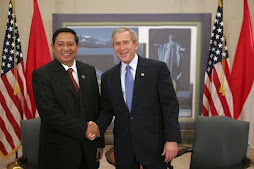From Alejandro and Marley
1. What type of landscape does Jakarta have?
2. How is the climate during various seasons?
3. Is it different adjusting to the new landscape?
4. What is the hottest season?
ANSWER: To decribe the landscape of Jakarta would be like describing Dallas, but in worse conditions. Jakarta is the largest city and has a population of over 13 million people...that's a lot of people especially considering that Jakarta is only 410 miles big. That's about 44,000 people p/square mile! It's a huge city on an island so of course there is a downtown area plus suburbs, there is development everywhere, people everywhere, cars everywhere, motorbikes everwhere, shops everywhere but don't fret there is a good side. Java, which is the name of the island that Jakarta is located sits between the Indian and the Pacific Ocean and is just south of the equator (actually Indonesia is one of 10 countries that the equator passes through) which makes it hot all year. So being in the city can be hot and congested but you can always escape for the weekend and go to one of the oceans and hang out at the beach and enjoy the sea breezes. I've lived in large cities before so I don't think adjusting will be difficult, it's more difficult dealing with the number of people that live here and being in a different culture. Sometimes I'm not sure how to dress when I go out being afraid that I might offend someone. The way the roads are designed is awfully confusing so that will take some time to get used to but for now, I carry a GPS where ever I go and record the location if I ever need to go back there.
There is really only one climate in Indonesia: Hot and Humid. All the time. There are 2 seasons, 2 Hot seasons one of which is wetter than the other, the Musim Hujan (museum hu-jahn) or wet season. It's actually cooler during this time but still hot and tropical. The wet season's tendencies can be contributed to the Pacific Ocean air masses and the Asian continent and the rain is phenomenol- a monsoon no less which is why Jakarta is prone to flooding. It downpours rain in buckets, spectacular lightning shows, thunder so loud you would think you're standing in between 2 huge drums as someone pounded on them so much the windows shake. The streets become rivers, children start swimming, public transport becomes free, taxi drivers will charge extra to go to a flooded area, and sewers overflow. I read somewhere that every 5 years boats are seen in Jakarta streets as clogged drains and rivers spill over. We've arrived at the end of the wet season which runs October thru February so now I only see a couple of thunderstorms a couple of times a week.
The other hot season is called Musim Kering (museum kuh-ring), the dry season. This is when no rain has fallen for months, water supplies are scarce and wells start drying up. If you don't have air conditioning the nights are hot and sticky and the mosquitoes are fierce. The dry season runs from May through September and are influenced by Australian continental air masses.
The exciting part about the landscape is that if you live in Indonesia, you live by a volcano. Indonesia has almost 400 volcanoes with about 100 being active and 30 of these are located on the island of Java, though mostly quiet. Jakarta is unaffected by volcanoes but there are 3 nearby and they are part of a national park and with the park's permission you can climb one. The most famous one is called Krakatau or officially known as Anak Krakatau (child of Krakatau) since the original one blew itself up in 1883. The last eruption of Anak Krakatau was in June/July of 2009 (see photo). The volcanoes in Indonesia are part of what's called the Pacific Ring of Fire (see photo) which is an area where a large number of earthquakes and volcanic eruptions occur in the basin of the Pacific Ocean (see map) and the volcanoes in Indonesia are the most active.
Subscribe to:
Post Comments (Atom)

















































No comments:
Post a Comment